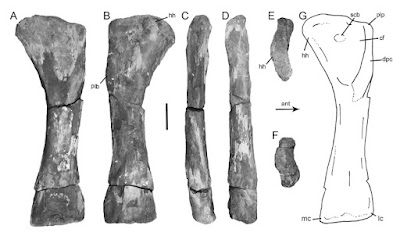Chucarosaurus
- unexpecteddinolesson
- Jul 2, 2023
- 3 min read
Updated: Apr 15
MEANING: Indomitable lizard
PERIOD: Late Cretaceous
CONTINENT: South America
Chucarosaurus is a large, slender-limbed colossosaur that reached about 30 m in length, and weighed around 50 t. Characteristics in its hips, forelimbs, and hindlimbs suggest that despite its massive size, Chucarosaurus was slender and more gracile than would be otherwise expected for such a large animal.

Abstract from paper: Chucarosaurus diripienda gen. et sp. nov. is a new and large titanosaurian sauropod from the Neuquén Basin, Rio Negro Province, Patagonia. The specimen was discovered in the Upper Cretaceous strata of the Huincul Formation (middle Cenomanian–lower Turonian). It includes appendicular and relatively slender elements, with a femoral total length of about 1.9 m long. This taxon shows a unique combination of characters indicating that appendicular bones such as the femur, ischium and tibia, show a remarkable morphological variety, greater than previously described, and are morphologically informative as source of phylogenetic data. A cladistic phylogenetic analysis placed Chucarosaurus well nested within the Colossosauria clade.
Chucarosaurus is from the Late Cretaceous. The Cretaceous is the third and final geological period of the Mesozoic Era, with the Late Cretaceous making up roughly the second half of it, lasting from about 100 to 66 million years ago. It was a time of significant evolutionary change, with dinosaurs reaching their greatest diversity before the mass extinction at the end of the Cretaceous.
The Cretaceous was a period with a relatively warm climate, though the Late Cretaceous experienced a global cooling trend, caused by falling levels of carbon dioxide in the atmosphere. The continents were nearing their present positions, but high sea levels flooded low-lying regions, turning Europe into an archipelago, and forming the Western Interior Seaway in North America. These seas were home to a variety of marine reptiles, including mosasaurs and plesiosaurs, while pterosaurs and birds shared the skies.
On land, dinosaurs continued to thrive and diversify during the Late Cretaceous, producing many of the most well-known groups, including tyrannosaurs, hadrosaurs, and pachycephalosaurs. Established Cretaceous dinosaur clades like the ceratopsians, ankylosaurs, and dromaeosaurs continued to flourish. Sauropod species consisted almost exclusively of titanosaurs, which seemed to be confined to the Southern Hemisphere for much of the Late Cretaceous. Flowering plants and grasses diversified and spread, becoming the dominant flora similar to what we see today.
The Cretaceous (along with the Mesozoic) ended with the Cretaceous–Paleogene (K–Pg) extinction event, a large mass extinction in which many groups, including non-avian dinosaurs, pterosaurs, and large marine reptiles, died out. This event, likely triggered by an asteroid impact, is marked by the abrupt K–Pg boundary, a distinct geologic layer separating the Mesozoic and Cenozoic Eras. In its aftermath, mammals and avian dinosaurs rapidly diversified, becoming the dominant land animals of the Cenozoic Era.

Chucarosaurus is a sauropod. Sauropods are saurischian dinosaurs that had very long necks, long tails, small heads (relative to the rest of their body), and four thick, pillar-like legs. They are notable for the enormous sizes attained by some species, and the group includes the largest animals to have ever lived on land. Well-known genera include Brachiosaurus, Diplodocus, Apatosaurus and Brontosaurus.
The oldest known unequivocal sauropod dinosaurs are known from the Early Jurassic, and by the Late Jurassic (150 million years ago), sauropods had become widespread. By the Late Cretaceous, one group of sauropods, the titanosaurs, had replaced all others and had a near-global distribution. This group included the largest animals ever to walk the earth. Estimates vary, but the largest titanosaurs are estimated at upward of around 40 m, and weighing 100 t, or possibly even more.
As with all other non-avian dinosaurs alive at the time, the titanosaurs died out in the Cretaceous–Paleogene extinction event. Fossilized remains of sauropods have been found on every continent, including Antarctica.











